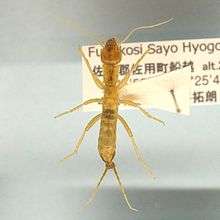Grylloblattidae
Grylloblattidae, the icebugs, or ice crawlers, is a family of extremophile (psychrophile) and wingless insects that live in the cold on top of mountains and the edges of glaciers. They belong, along with Mantophasmatidae (rock crawlers), to the order Notoptera.[2] Grylloblattids are tiny, most being less than 3 cm long, wingless insects with a head resembling that of a cockroach, with long antennae and having elongated cerci arising from the tip of their abdomen. They cannot tolerate warmth (most species will die at 10° C) and many species have small distribution ranges.
| Grylloblattidae | |
|---|---|
 | |
| Galloisiana nipponensis | |
| Scientific classification | |
| Kingdom: | Animalia |
| Phylum: | Arthropoda |
| Class: | Insecta |
| Order: | Notoptera |
| Suborder: | Grylloblattodea |
| Family: | Grylloblattidae E. M. Walker, 1914 |
| Genera | |
|
Galloisiana | |
Overview
Grylloblattids, ice crawlers or icebugs puzzled the scientists who discovered them in 1914, E.M. Walker and T.B. Kurata; the first species named was Grylloblatta campodeiformis, which means "cricket-cockroach shaped like a Campodea" (a kind of two-pronged bristletail). Most are nocturnal and appear to feed on detritus. They have long antennae (23–45 segments) and long cerci (5–8 segments), but no wings. Their eyes are either missing or reduced and they have no ocelli (simple eyes).[3] Their closest living relatives are the recently discovered Mantophasmatodea.[4] Most species are less than 3 cm long, the largest being Namkungia magnus.[5]
The family has its own suborder, Grylloblattodea (formerly[2] its own order). It contains 5 genera and about 34 extant species.[6][7]
Most species have restricted distributions and small populations and with increased warming their habitats are threatened, making them endangered. In North America some species like Grylloblatta barberi and G. oregonensis are known from single sites.[8]
Habitat and distribution
Grylloblattodea are nocturnal extremophiles typically found in leaf litter and under stones in extremely cold environments, usually at higher elevations. They are known to inhabit cold temperate forests to glaciers and the edges of ice sheets. Their optimal living temperature is between 1-4 °C (33.8-39.2 °F). They can be killed at colder temperatures due to ice formation in the body, so when the temperature drops below their optimal range they survive by living under snow pack near the soil.[9] They have a very narrow range of temperatures that they prefer and cannot withstand high temperatures; many species are killed when the temperature rises about 5°C above their optimal. They move in response to the seasons so as to maintain an optimal temperature in their foraging habitat.[10]
Grylloblattidae are patchily distributed on glaciers in North America, China, Siberia, Korea and Japan. They are predicted to occur in several other mountain chains in Asia including parts of the Himalayas.[11]
Diet
They are omnivorous, but feed primarily on dead arthropods and carrion. When arthropod carcasses are scarce, their diet relies heavily on plant material.[9] The fossil species Plesioblattogryllus magnificus from the Middle Jurassic had strong mandibles and is thought to have been a predator.[11]
References
- H. V. Hoell, J. T. Doyen & A. H. Purcell (1998). Introduction to Insect Biology and Diversity (2nd ed.). Oxford University Press. p. 320. ISBN 978-0-19-510033-4.
- Arillo, A. & M. Engel (2006) Rock Crawlers in Baltic Amber (Notoptera: Mantophasmatodea). American Museum Novitates 3539:1-10
- Richards, O. W.; Davies, R. G. (1977). "Grylloblattodea". Imms' General Textbook of Entomology. Springer Netherlands. p. 533. doi:10.1007/978-94-011-6516-7_9. ISBN 978-0-412-15230-6.
- Stephen L. Cameron, Stephen C. Barker & Michael F. Whiting (2006). "Mitochondrial genomics and the new insect order Mantophasmatodea". Molecular Phylogenetics and Evolution. 38 (1): 274–279. doi:10.1016/j.ympev.2005.09.020. PMID 16321547.
- . doi:10.5281/zenodo.174644. Cite journal requires
|journal=(help); Missing or empty|title=(help) - Terry L. Erwin (1997). "Biodiversity at its utmost: tropical forest beetles". In Marjorie L. Reaka-Kudla, Don E. Wilson & Edward O. Wilson (ed.). Biodiversity II. Washington, D.C.: Joseph Henry Press. pp. 27–40. ISBN 978-0-309-05584-0.
- Zhang, Z.-Q. (2011). "Phylum Arthropoda von Siebold, 1848 In: Zhang, Z.-Q. (Ed.) Animal biodiversity: An outline of higher-level classification and survey of taxonomic richness" (PDF). Zootaxa. 3148: 99–103. doi:10.11646/zootaxa.3148.1.14.
- Schoville, Sean D (2014). "Current status of the systematics and evolutionary biology of Grylloblattidae (Grylloblattodea)". Systematic Entomology. 39 (2): 197–204. doi:10.1111/syen.12052.
- David Grimaldi, Michael S. Engel (2005). "Polyneoptera: Grylloblattodea: The Ice Crawlers". Evolution of the Insects. New York City: Cambridge University Press. pp. 222–224. ISBN 9780521821490.
- Schoville, Sean D.; Slatyer, Rachel A.; Bergdahl, James C.; Valdez, Glenda A. (2015). "Conserved and narrow temperature limits in alpine insects: Thermal tolerance and supercooling points of the ice-crawlers, Grylloblatta (Insecta: Grylloblattodea: Grylloblattidae)". Journal of Insect Physiology. 78: 55–61. doi:10.1016/j.jinsphys.2015.04.014. ISSN 0022-1910. PMID 25956197.
- Bai, Ming; Jarvis, Karl; Wang, Shu-Yong; Song, Ke-Qing; Wang, Yan-Ping; Wang, Zhi-Liang; Li, Wen-Zhu; Wang, Wei; Yang, Xing-Ke (2010). "A Second New Species of Ice Crawlers from China (Insecta: Grylloblattodea), with Thorax Evolution and the Prediction of Potential Distribution". PLoS ONE. 5 (9): e12850. Bibcode:2010PLoSO...512850B. doi:10.1371/journal.pone.0012850. PMC 2943926. PMID 20877572.
External links


- Video of a walking grylloblattid